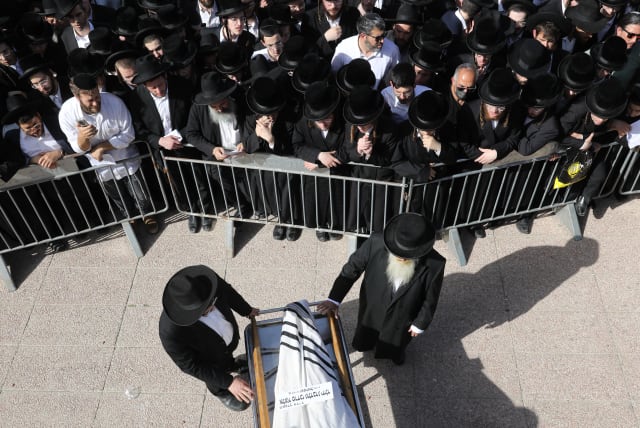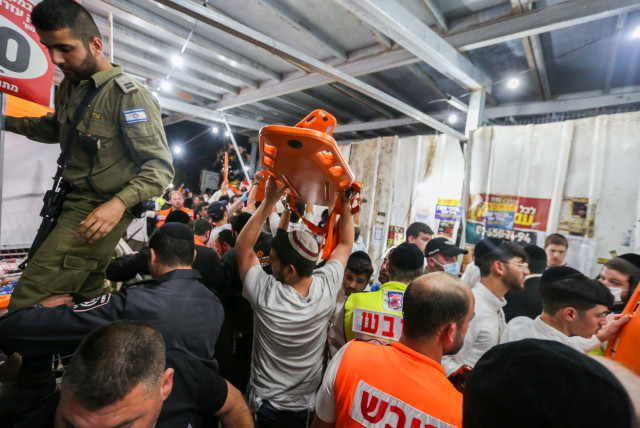Meron Disaster Commission finds Netanyahu, police, and officials responsible for catastrophe

The interim report advised the appointment of a minister in charge of the celebrations and recommended that infrastructure be improved at the site to remove safety hazards.
Prime Minister Benjamin Netanyahu, Israel Police commanders, and local officials were personally responsible for the 2021 Mount Meron crowd crush that claimed the lives of 45 people, according to the Mount Meron Disaster Commission’s final report, submitted to the government at noon on Wednesday.
The report detailed how negligence, lack of preparation, absent governance, no enforcement of construction law, and conflict over responsibilities, authority, and land ownership by politicians, civil servants, and law enforcement led to dangerous overcrowding and hazardous and illegal facility conditions, year after year, during the pilgrimage to the tomb of Rabbi Shimon Bar Yochai Tomb for Lag Ba’omer.
While the potential for disaster was known by the involved authorities – they even feared such an event – they did not seize the opportunity to improve conditions, the commission said.
“The disaster could and should have been prevented,” it said. “The writing was on the wall long before. It was not known when it would happen, on whose watch, or in what part of the site. It was impossible to know what the price would be, how many worshipers would pay for their lives and health, and how many families would be left broken. But it was clear that the disaster would come.”
The cause of the tragedy
The disaster unfolded when a large crowd sought to attend a bonfire lighting and attempted to funnel into a narrow and steep stairway that was slick with spilled drinks. When some people fell, the crowd behind them continued on the path, resulting in extreme pressure and suffocation of the victims.
The committee held 16 officials personally responsible for the event, out of the 18 reviewed for their role. The judgment of personal responsibility was in a broad ethical sense and carries no legal weight. Eleven organizations were castigated for their role.

Netanyahu was held personally responsible, as the head of state at the time. The committee declined to issue a recommendation for him because his position is an elected one, so it is for the public to decide. The committee said he and the Prime Minister’s Office had failed in their leadership over the disputes between ministries and government bodies on the disaster.
There were multiple requests for Netanyahu to intervene, the commission said, but those requests were not forwarded to him. The commission recommended that in the future, the Prime Minister’s Office should prioritize informing the prime minister of issues and interministerial disputes that pose risks to human life.
The internal security minister at the time, Amir Ohana (Likud), was another senior politician held responsible. The commission recommended avoiding his appointment to the position in the future.
The Internal Security Ministry did not actively pursue delegation and legal regiment for Mount Meron and let different bodies argue over it, the commission said. Despite the celebration being one of the biggest annual events supervised by the police, the ministry did not have dedicated staff on the project. The police force also falls under its purview, which the commission slapped a scathing review on, citing a lack of preparation and proper law enforcement.
Israel Police Insp.-Gen. Kobi Shabtai was responsible for what happened, the commission said, adding that it would have recommended that he be replaced but left the decision to the government for when he leaves office due to the war.
The commission recommended that Israel Police Northern District Supt. Shmuel Piamante, who was in charge of security and licensing, be fired. It recommended that Shalom Avitan, the regional deputy superintendent and Nof Hagalil station commander; and Brig.-Gen. Assaf Mansour be fired, but they both had already retired.
It recommended that Nof Hagalil intelligence officer Assaf Sheikh not be promoted for four years, adding that involvement in the disaster should be considered when promoting or assigning security and licensing commander Morris Chen. The committee declined to impose blame on ex-Northern District Cmdr. Shimon Lavi, who said he had acted befitting of his station by immediately taking responsibility, resigning from his position, and leaving the police in June.
The police were considered responsible for preparation, outlining requirements, and management. Licenses were given without proper security and safety reviews, the commission said, adding that police operated under the concept that measures to limit attendance were more dangerous than allowing full access. There was no set level for how large the crowd could grow, with officers operating off a rule of thumb. Security plans were submitted without detail and detached from reality.
Officers testified that they were not familiar with operational plans. Junior officers had insufficient briefings and were not instructed on how to deal with congestion. Forces lacked a common operational language, which resulted in a 15-minute response delay. When they did arrive, there was no standard operating procedure for a crowd-crush event.
The commission recommended that police formulate clear safety and security plans. Following the event, police failed to immediately launch an investigation. The commission suggested that the force develop procedures to investigate unusual events.
The police and the National Center for the Development of Holy Sites clashed on the appointment of a Lag Ba’omer event manager, leaving no party responsible. Police demands for infrastructure changes and pre-event engineering inspections were not implemented.
The commission recommended that the center’s director, Rabbi Yosef Schweinger, be fired or voluntarily resign following the release of the report. It was recommended that the government reconsider the center’s continued existence.
An organization responsible for more than 130 holy sites did not maintain the Meron site, the commission said. It did not remove safety hazards, develop egresses for emergencies, improve improper stairways, and not only did not work with authorities to prevent dangerous and illegal construction, but it also engaged in these practices.
The center hired Reuven Ben-Gal, a Meron celebration security chief who could not meet the demands of the job for medical reasons, while the center’s crowd limits only existed on paper. Ben-Gal was also deemed personally responsible, and it was recommended that he not be allowed to be a security manager for mass events.
The Religious Services Ministry, which failed to supervise the subordinate Holy Sites Center, failed to appoint a board of directors to oversee the organization. Consequently, it was advised that then-minister Rabbi Ya’akov Avitan not be given a ministerial portfolio in the future. Director-General Oded Plus was not found to be responsible. The Government Companies Authority was also found not to have been monitoring the center’s activities, and the Registrar of Associations had not conducted an audit on it since 2007.
The Committee of Five, established by a 2008 Supreme Court ruling to coordinate between different claimants to various land endowments at Mount Meron, was found by the committee to have failed in its mission and was recommended to disband.
It did not manage the site and was rife with disagreements and an inability to compromise. Due to land ownership issues, other bodies could not implement decisions, and the committee had to rely on other organizations for hiring and contracts because it was not a legal entity. Despite the body’s failure, committee chairman Rabbi Shmuel Rabinowitz was deemed not at fault and had tried to fix all the issues.
One of the land leases was by the Israel Lands Authority to Yeshivot Bnei Akiva, and the ILA was aware that the lands were not being used by the terms of the lease. Bnei Akiva was making a profit from the land, but it had been granted the lease without recompense.
The Upper Galilee Regional Council and the local planning and construction committee, as well as other national level bodies, did not act to enforce law and order at Meron, issuing business licenses retroactively, and also did nothing to implement crowd restrictions.
The Marom Hagalil Regional Council and local planning and construction committee were deemed dysfunctional, dealing with the site as if it was not within its territory. Council head Amit Sofer was deemed especially personally responsible, but he is an elected official.
The council did not address widespread illegal construction at the site. It treated it as not its territory and allowed events to occur without proper licensing, leading the committee to recommend that all construction and licensing powers be taken from the councils and given to Northern District Land Authority. The National Authority for Real Estate Enforcement also refrained from enforcing laws against what it knew was dangerous and illegal construction at Mount Meron.
The commission recommended that the safety engineer of Hillot Tashpa, Amer Khaliliya, not be in such a role in the future, have his engineer’s license examined for cancellation, and that the attorney-general consider a criminal investigation. It was also suggested that Lag Ba’omer security manager Shimon Malka be investigated and not have a role as a security manager.
Hachnasat Orchim Rashbi Association manager Meir Carlebach was also held responsible, but because of health issues, would not be active at Meron anymore, so no recommendations were made.
The commission reiterated previous recommendations for an end to the complex and dysfunctional management of the site and to appoint a minister with clear executive powers. The land should be expropriated by the state so it could properly manage the site, it said, and the Labor Ministry should be in charge of issuing safety licenses for mass events.
To prevent crowding, the commission said each year there must be an event outline with maximum occupancy based on safety standards and infrastructure conditions. It recommended that authorities continue using a transportation system that regulates arrival.
Within the site, the commission said there should be one central lighting of the traditional bonfires to prevent unnecessary mass movement. Further, the report said more areas should be allocated for the crowds, the gravesite devoted to prayer and study only, and celebrations and dancing in certain areas. No food and beverages would be distributed at the site.
The committee said it hoped the recommendations would change the organizational culture of public bodies in the country and establish proper norms of public responsibility. Many of the broad recommendations had been suggested in the 2021 and 2022 interim reports the commission issued.
The commission had been formed two months after the disaster. The committee members, former Supreme Court president Miriam Naor, Rabbi Mordechai Karelitz, and Maj.-Gen. (res.) Shlomo Yanai, were appointed by then-Supreme Court president Esther Hayut. Naor died in February 2022 and was replaced by former Tel Aviv District Court president Devorah Berliner.
The commission collected tens of thousands of documents and 189 testimonies, and it held several tours of the site in the process of creating the report. After the report’s submission, copies were sent to the families of the victims, and notifications were sent to those held personally responsible.
